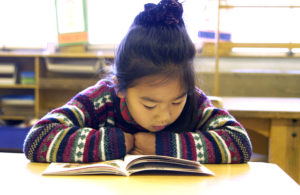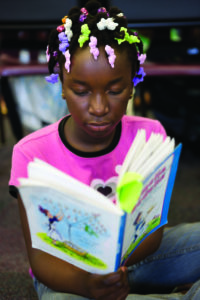I have a confession to make. When it comes to children’s literature, I like chapter books more than picture books. I feel much better now. I needed to get that off my chest. I felt dirty hiding it from you all.
I was reminded of this recently when I was reading with my own daughter. At the end of each evening, just before bed, my daughter, my wife, and I huddle together and take turns reading aloud. She is now old enough for us to read the books that I loved reading with my students. Over the weekend we finished Because of Winn-Dixie by Kate DiCamillo. (If you have not read this book you need to-today.) Right now we are reading Roald Dahl’s classic, Charlie and the Chocolate Factory. We all love the story—that does not surprise me. What surprises me is my daugther’s reaction to the process and the thinking she does as the book progresses.


On Tuesday we came to the part of the book where children around the world are beginning to find Wonka’s golden tickets. It was Charlie’s birthday, his family all chipped in to give him a Wonka bar to see if he too would find a ticket. As we read, my daughter was clearly becoming more excited. She pulled on my arm, she kept sticking her head in front of my wife (whose turn it was to read). She was trying to read ahead to see if she could discover if he got the ticket or not. Then at the climactic scene of that chapter when we discovered that Charlie’s chocolate bar did not have the golden ticket, my daughter was distraught.
“The title of the book is Charlie and the Chocolate Factory,” she shouted indignantly. “He had to get that ticket, it just does not make sense.” We stopped reading for the night so she could go to bed. (Which of course she was overjoyed to do-displaying a bit of her own interpretation of Veruca Salt.) We talked a bit about the story and finally coaxed her into bed. The next morning as I was making her breakfast, she started talking about the book.
“You know daddy,” she said, “he’s got to find that ticket.”
“Huh?” I said in a groggy, pre-coffee voice. “Why in the world do you think that?”
“I mean,” she replied, “What’s the point of writing the book if he does not find the ticket? I just wonder how it will happen. Charlie’s family does not have money to go and buy more chocolate for him. But he’s got to find that ticket. What is he going to do?”
This reminds me of the critical role that reading longer books plays in children’s literacy. Over the days we have been reading this book, Karina has been developing her own very particular line of thought about the book. Each chapter tests that theory and adds to or changes it. She knows because of the buildup of the first few chapters, the title, and her experience with other texts that Charlie will somehow find the ticket. What I find important and interesting is how the story lingers in her mind in between readings. As a parent, it is a fantastic way to bring my family closer together at the end of each day. As a teacher, I know that this is critical skill my students need to develop.
The challenge, of course, is to find time in our already too-full days to linger over books together. “Lingering over texts” does not appear often in our state standards. Nor does crying together over the death of a character we have come to know and love over weeks of reading like when my fourth graders read The Bridge to Terabithia. Buy the crying, lingering, giggling, and huddling together over books forms the garden where our ideas grow.
We have to take the time.
Also see this post on picture books by Kenni Smith.
